ELECTRONIC
SACKBUT (1945-1973)
Le Caine built the
Electronic Sackbut between
1945 and 1948. It is now recognized to
have been
the first voltage-controlled synthesizer.
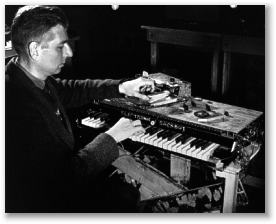
Hugh
Le Caine at the Sackbut. |
In 1945, when
the first Sackbut was built inside a desk, Le Caine visualized
an instrument in which the operator would control three aspects
of sound through operations on the keyboard in three co-ordinates
of space: vertical pressure was to correspond to volume; lateral
pressure to pitch change; and pressure away from the performer
to timbre.
The control devices
were force sensitive. They would alter the sound in response to
changes in pressure, something the operator could feel without
carefully watching the controls. The timbre controls, however,
were soon considerably expanded and could no longer be operated
by a single device.
Two innovative techniques
stand out in the design of the Sackbut: the use of adjustable wave
forms as timbres and the development of voltage control. It is in
this regard that the Sackbut is recognized to be the forerunner
of the synthesizers of the 1970's.
Below:
- The 1948 Prototype
- Playing the
Sackbut
- The Sackbut
Synthesizer
- Inside the
1971 Sackbut
The 1948 Prototype
|
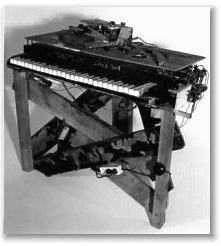
The
original 1948 Sackbut.
|
The prototype
of the Electronic Sackbut, completed in 1948, is now in the
collection of the National Museum of Science and Technology.
As seen here, it was built on a minimal stand using three
legs and three cross pieces. Le Caine did not feel it was
an appropriate use of his time to improve the appearance of
the instrument by removing the staples and scraps of cloth
from the boards that made up the stand.
This photograph was taken in 1954 soon after Le Caine began
to work full time designing electronic music instruments at
the National Research Council. |
The right hand
controls the keyboard, playing one note at a time, and applying
both vertical pressure to affect volume and horizontal pressure
to affect gradual change in pitch. The left hand controls several
aspects of the timbre of the sound.
|
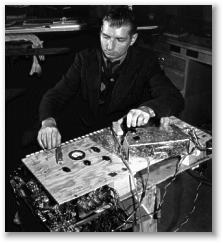
Le
Caine with the Prototype
Sackbut in 1954.
|
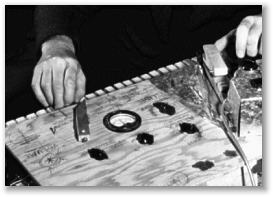
The
wooden top of the 1948 Sackbut; note the pencilled
indications written on the instrument's top. |
Playing
the Sackbut
The control of
timbre on the Sackbut was accomplished by the left hand, each
finger operating a separate pressure-sensitive control.
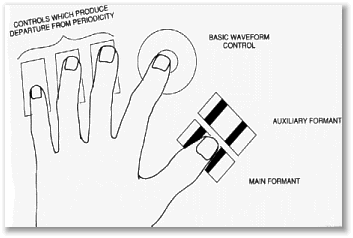
The device to
continuously alter the wave form was operated by the index finger
of the left hand. A moveable pad, shown by dotted lines, made
connections at any point within the larger grid of possibilities.
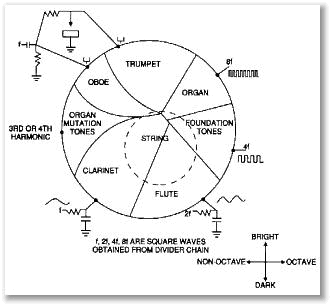
The Sackbut Synthesizer
In 1969, Le Caine
began to
redesign
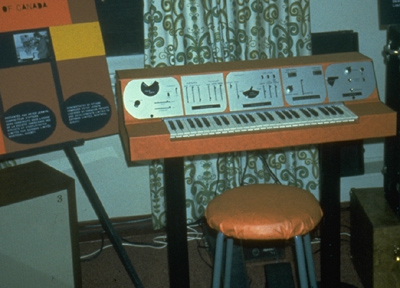
The
commercial prototype of the Sackbut Synthesizer. |
the 1948 Sackbut
using modern techniques.
By 1971 this working prototype
was completed, and there was an attempt to manufacture the instrument
commercially as a voltage-controlled electronic keyboard instrument.
The final Sackbut
used integrated circuits for the level controls and had an extra
octave position, bringing the range of the instrument to seven
octaves, its envelope control could be played in reverse without
extra adjustments. Plans were made for an instrument with three
oscillators but this was never built.
Inside
the 1971 Sackbut
|
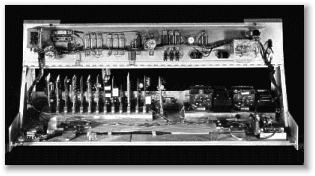
Inside
the 1971 Sackbut.
|
|
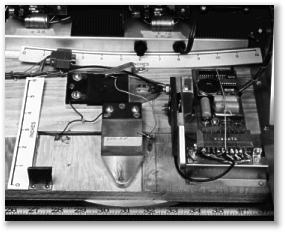
The
pressure sensitive devices on the 1971 Sackbut were considerably
refined over those of 1948.
|
Le Caine also
designed pressure sensitive devices to control aspects of timbre
(to control the degree of frequency modulation with low register
noise, and the addition of high register formant frequencies).
There was also a device for continually and quickly adjusting
the wave shape.
|









